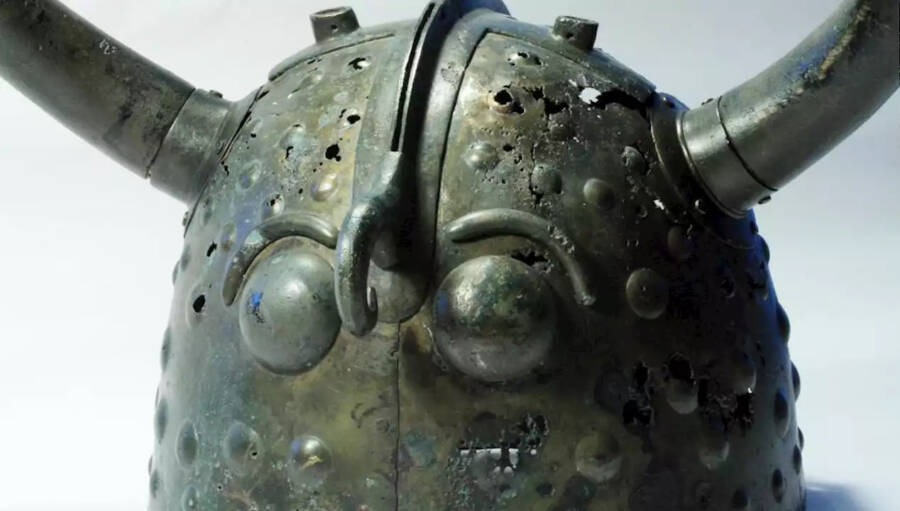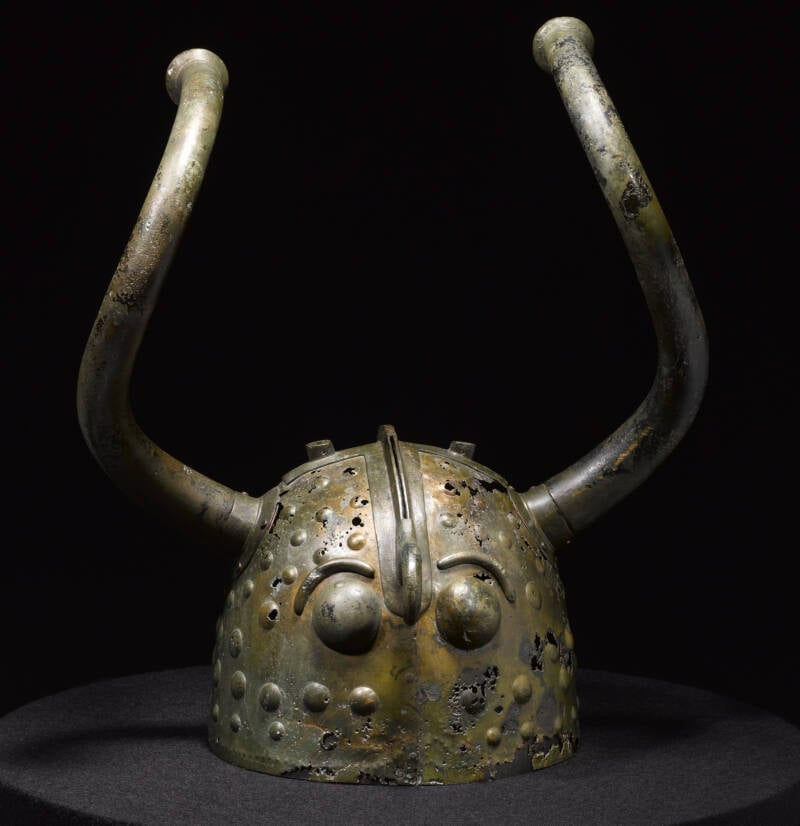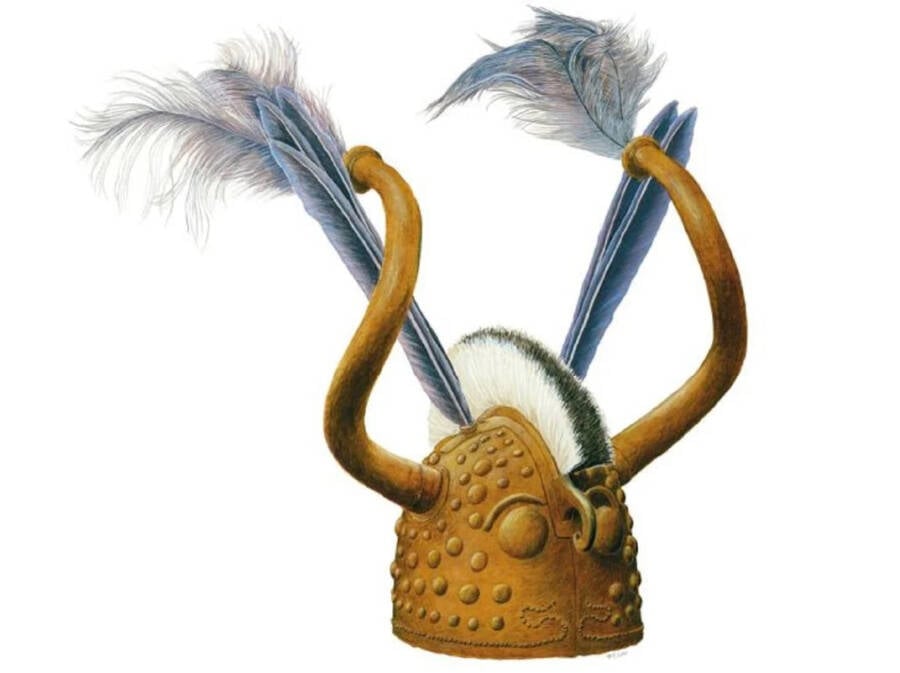The two horned helmets were uncovered by a peat cutter in Viksø, Denmark, in 1942 and have just been dated to 900 B.C. — confirming they were never worn by Vikings.

National Museum of DenmarkThe horned helmets had fittings that formerly carried feathers and a horsehair mane.
For longer than living memory, horned helmets have dominated the popular image of the Vikings. But new research shows that this daunting headgear predated the Norse warriors by nearly 2,000 years — and that the Vikings likely never wore horned helmets at all.
The tie between horned helmets and Vikings was already so firm that when a peat cutter unearthed a pair of them from a bog in 1942, they were assumed to be from the Viking era, which began around 800 A.D.
But this assumption was only held in the popular sphere, as scholars soon dated them to the Nordic Bronze Age between 1750 and 500 B.C. Only recently, however, have scientists established a more precise date. According to CNN, however, Danish archaeologist Helle Vandkilde has now officially dated them to between 907 B.C. and 857 B.C.
“For many years in popular culture, people associated the Viksø helmets with the Vikings,” said Vandkilde of Aarhus University. “But our research confirms that the helmets were deposited in the bog in about 900 B.C., almost 3,000 years ago and many centuries before the Vikings or Norse dominated the region.”
Still, the dating of the Viksø helmets has given experts much to ponder. According to LiveScience, historians and archaeologists have already begun to reassess how tightly connected Bronze Age civilizations truly were — and how imagery of horned helmets spread across Europe.

National Museum of DenmarkOne of the horned Viksø helmets on display.
The two horned helmets were discovered in a bog in the area of Brøns Mose in the town of Viksø at the height of World War II. A farmer digging peat stuck metal about two feet below the surface, which led to a closer inspection by his foreman. It was then that the two workers realized they had uncovered fragments of a decorated bronze object.
Researchers from the National Museum of Denmark soon identified the remnants as parts of two helmets. They also dug up the remains of a wooden slab from the bog that was thought to have been used as a stand for the helmets to be ritualistically placed in the bog.
But the helmets proved enigmatic. The metal of the helmets couldn’t be dated using radiocarbon techniques, and the experts began to suspect that the ancient wooden slab must have been placed in the bog far earlier than the helmets. Remarkably, it was only in 2019 that one of Vandkilde’s peers spotted new clues.
“She noticed that there was primary organic material in the horns and spoke to a colleague at the National Museum responsible for the collection, and they agreed to send a sample for absolute dating,” said Vandkilde.

National Museum of DenmarkThe tar found on one of the horns was finally dated in 2019.
As published in the Praehistorische Zeitschrift journal, the study revealed that this material was birch tar stuck to one of the horns, which can be carbon dated. Before this study, researchers dated the helmets by analyzing their style and symbology.
“Typology is quite often a good first step, chronologically speaking, but it is very important when we can have absolute dates, as we can with carbon 14,” said Vandkilde. “We now know with this new date that the helmets were deposited in the bog, perhaps by someone standing on a wooden platform, around 900 B.C.”
According to Vandkilde, these helmets starkly resembled similar depictions in rock art and figurines of the same era across Spain, Sardinia, and Scandinavia.
The study suggested these helmets, which had fittings used for attaching feathers and horsehair, were worn for symbolic displays of power rather than for battle. At the time, Scandinavian cultures were shifting from Sun worship to deities associated with animals. And the helmets’ design elements showcase this transition.
The front of the helmets features two large eyes and a beak, symbolizing a bird of prey, while the top crown of the helmet would have once held horsehair cut like a mane. And the two massive horns represent a bull.
“Our study shows that Scandinavian depictions of horned warriors occur at the same time as very similar images in Sardinia and southwest Spain,” she said. “This testifies to the tight connections between the great civilizations of Bronze Age Europe; the first globalization based on long-distance trade in metals, ideas, and luxuries.”

National Museum of DenmarkHistorians believe the helmets were used as symbols of power rather than as battle gear.
According to The Smithsonian, the current theory holds that Phoenician travelers reached Europe from the Levant by sea across the Mediterranean. The study said that the Near East and the Mediterranean “boast a deep history of horned-helmet figures connected with divine rulership and with warfare.”
Since Scandinavia had scarce metal resources, their civilization welcomed trading copper and tin with cultures from Southern Europe. Furthermore, with no imagery of horned helmets emerging across the land-based trade routes across the Alps, it seems clear that these cultures were seafaring in their dealings.
“These [helmets] are new indications metals were traded further than we thought,” said Vandkilde. “Ideas were co-travelers.”
After reading about horned helmets predating the Vikings by millennia, learn about 32 Viking facts that reveal one of history’s most misunderstood civilizations. Then, read about the Viking berserkers who entered a trance-like rage during battle.





